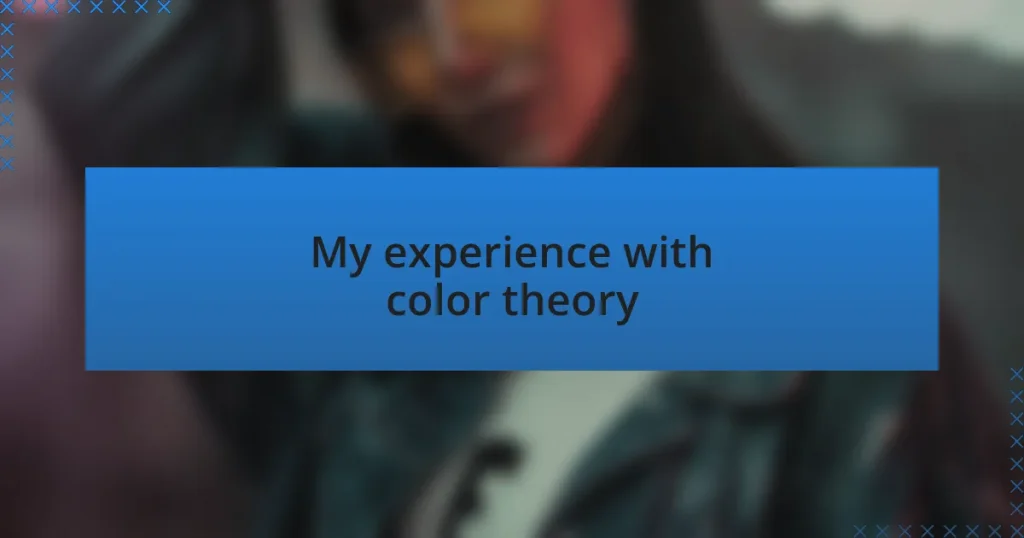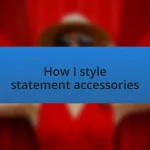Key takeaways:
- Color theory is crucial in understanding how colors influence emotions, personal style, and perceptions in fashion.
- The color wheel helps in recognizing color relationships, including complementary and analogous colors, to create impactful outfits.
- Combining colors effectively, such as through the 60-30-10 rule, can enhance outfit balance and personal expression.
- Personal color palettes reflect individual emotions and experiences, revealing deeper connections to one’s identity and mood.
Author: Charlotte Hawthorne
Bio: Charlotte Hawthorne is an acclaimed author known for her compelling storytelling and richly drawn characters. With a passion for exploring the complexities of human relationships, her novels often blend elements of romance, intrigue, and self-discovery. A graduate of the University of California, Charlotte has received multiple awards for her work, including the prestigious Silver Quill Award. When she’s not writing, she enjoys hiking in the Sierra Nevada mountains and sipping coffee at local cafes. Charlotte currently resides in San Francisco with her rescue dog, Jasper.
Understanding color theory
Color theory is a fascinating framework that helps us understand how colors interact, evoke emotions, and can influence personal style. I remember the first time I took a step back and recognized how the colors I choose can tell a story about who I am. Have you ever worn a bright red dress and felt a surge of confidence, or opted for soft pastels and felt more serene? It’s intriguing how certain shades can shape our moods and the perceptions of those around us.
At the core of color theory are concepts like the color wheel, which categorizes hues in a way that highlights their relationships. Complementary colors, for instance, create striking contrasts that can elevate an outfit, drawing the eye and creating a sense of balance. I often think about how combining vibrant turquoise with a warm coral can make a statement like no other; it’s all about creating that visual harmony that resonates with who you are.
Understanding warm and cool colors can also change the game in your wardrobe. When I discovered how yellow and orange can add warmth to my look, it was a revelation. The right mix can even enhance your features, making your eyes pop or your skin glow. Have you explored your color palette? Engaging with this aspect of color theory has not only transformed my style but has deepened my appreciation for the art of fashion itself.
Importance of color in fashion
Color is more than just a visual element in fashion; it’s a powerful tool that can convey emotions and messages without a single word. I remember selecting a navy blazer for a job interview and feeling an instant wave of professionalism wash over me. Have you ever considered how your outfit might speak to your mood or aspirations? The colors we choose can empower us and influence others’ perceptions, making it crucial to understand their significance.
Different colors can also set the tone for any occasion. I once wore an all-black outfit for a dinner party and felt both sleek and mysterious, while a bright floral dress at a summer picnic instantly lifted my spirits. The color palette can transform a mundane day into something memorable and special. How do you want to be perceived? Your choices can help you curate not just your appearance but your entire experience.
Moreover, color plays a vital role in creating a cohesive wardrobe. After years of experimenting, I found that sticking to a specific color palette made mixing and matching my outfits a breeze. This strategy not only simplifies getting dressed but also allows for a greater expression of my personal style. How often do you refresh your wardrobe with new hues, and what do those colors say about you? Embracing the importance of color can elevate your fashion game and bring an entirely new layer of depth to your style journey.
Basic color wheel concepts
The color wheel is a fundamental tool in understanding color relationships, consisting of primary, secondary, and tertiary colors. I vividly recall my art class where we mixed red and blue to create purple, realizing how colors can interact beautifully. Do you remember the sense of excitement when you discovered how colors blend and transform? That moment not only sparked my creative journey but also opened my eyes to the significance of color combinations in fashion.
In my experience, complementary colors—those that sit opposite each other on the color wheel—can create striking contrasts that make an outfit pop. For instance, I paired a mustard yellow top with a deep violet skirt, and the result was nothing short of captivating. Have you ever dared to wear colors that, at first glance, seemed incompatible? The right pairing can elevate your look and draw attention to your personal style in unexpected ways.
Another key aspect of the color wheel is the idea of analogous colors, which sit next to each other and offer a harmonious blend. I once styled an outfit with different shades of blue and green for a casual brunch, and it felt both serene and refreshing. How do you feel when you wear colors that effortlessly complement each other? Understanding these relationships can not only enhance your wardrobe but also express the mood you wish to convey, making your fashion choices even more meaningful.
Combining colors for outfits
When it comes to combining colors for outfits, I often turn to the classic 60-30-10 rule. This guideline suggests using 60% dominant color, 30% secondary color, and 10% accent color for a well-balanced look. I remember experimenting with this while putting together an autumn ensemble: a rust orange dress (the dominant color), olive green accessories (the secondary color), and a striking teal scarf (the accent). The result was a visually engaging outfit that turned heads and made me feel vibrant.
I find that incorporating a neutral color can serve as a versatile base for any outfit. For instance, during a busy week, I opted for a charcoal gray blazer paired with a soft blush blouse and rich burgundy trousers. The neutrals grounded the look, allowing the bolder colors to shine without overwhelming the eye. Have you noticed how the right neutral can sometimes be the secret ingredient to perfecting your style?
Embracing trends also plays a significant role in color combination. When neon colors became popular, I hesitated but then decided to pair a neon pink top with a classic denim skirt. Surprisingly, the energetic vibe of the neon against the timeless denim created a playful contrast that sparked my confidence. Have you ever stepped out of your comfort zone with color? That leap can lead to exciting and fresh outfits that truly represent your unique personality.
My personal color palette
When I think about my personal color palette, I realize that it’s really a reflection of my personality and how I want to express myself each day. For instance, I’ve always gravitated towards earthy tones, like deep greens and warm browns, which bring a sense of calm and grounding to my style. I remember wearing a cozy olive sweater during a particularly stressful week, and it felt comforting, almost like a reassuring hug.
I also love experimenting with splashes of color to bring my outfits to life. Recently, I paired a soft cream top with bright mustard trousers, and the combination was delightful. It’s fascinating how a burst of color can alter your mood—every time I wear those trousers, I can’t help but feel cheerful and energized. Have you noticed how colors can truly transform not just your outfit but your entire day?
Sometimes, my color choices go beyond aesthetics; they signify different emotions or stages in my life. For example, when I was navigating a big career change, I found myself leaning toward bold blues, which seemed to embody confidence and determination. It’s interesting how our color preferences can reflect our inner state, almost like an emotional barometer. Do you have certain colors that resonate with your experiences, too?
Favorite color combinations
One of my all-time favorite color combinations is navy blue and blush pink. I stumbled upon this pairing while putting together an outfit for a wedding. The deep navy provided a beautiful backdrop, allowing the soft blush to stand out delicately. Whenever I wear this combo, I feel both sophisticated and approachable, a balance that reflects my personality.
Another winning duo in my wardrobe is olive green and burnt orange. I discovered this combination during a fall outing when I decided to wear an olive trench coat with a burnt orange scarf. The contrast felt warm and inviting, encapsulating the essence of the season. It’s interesting how color can evoke emotions tied to specific memories, isn’t it? After that day, I always look forward to fall fashion.
Then there’s the timeless black and white. I remember dressing in a classic black and white ensemble for a job interview, feeling instantly empowered. There’s something striking about how these two shades can create a chic, polished look. I often find myself wondering—how does a simple combination like this have such a profound impact on our confidence? It really highlights the power of colors in our daily lives.
Lessons learned from color exploration
Engaging with color has taught me the art of balance. I recall experimenting with a vibrant red dress for a dinner event and pairing it with softer accessories. The result was an eye-catching look that felt bold yet approachable. This experience reinforced my belief that contrasting colors can harmonize beautifully if paired thoughtfully. Have you ever noticed how certain shades can harmonize perfectly, transforming your entire vibe?
From my exploration, I’ve also learned that color can influence mood. I remember wearing a serene blue sweater on a particularly stressful day. Instantly, I felt more at ease, almost as if the color was soothing my mind. It’s fascinating how colors can resonate within us, offering comfort during turbulent moments. Have you ever chosen a color based on how it made you feel at that moment?
Lastly, I discovered that personal style extends beyond trends; it’s about how colors represent our identity. Once, while shopping, I found myself drawn to earthy tones, reflecting my love for nature. Wearing these hues felt like expressing a piece of myself. This taught me that our choices in color are not just aesthetic—they tell our stories. What do your color choices say about you?


